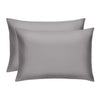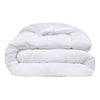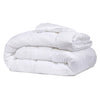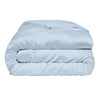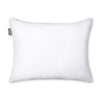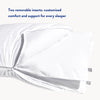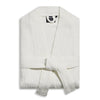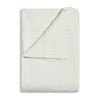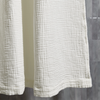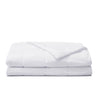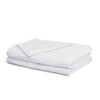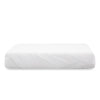The Daily Miracle
How To Get Rid Of An Allergic Reaction To Laundry Detergent
Published
June 19, 2025
Author
Suze Dowling

Few things are more frustrating than realizing your laundry routine is behind the itchy skin, redness, or unexpected rashes you've been experiencing for years. The important thing is, you've found the culprit and can do something about it. Lots of people deal with irritation and discomfort from using the wrong detergent. While finding relief might feel daunting, there are practical solutions that can help. In this article, we've laid down clear steps for treating a laundry detergent allergic reaction, tips for dealing with detergent rashes, and a small guide on how to pick hypoallergenic detergents to keep your skin happy.
What Are The Common Signs Of A Laundry Detergent Allergy?
A laundry detergent allergy, also called contact dermatitis, happens when your skin reacts to chemicals in laundry products. Signs include an itchy rash, commonly showing up where your skin made direct contact with treated clothes, like wrists, ankles, and torso. You might also notice redness, dryness, or, in severe cases, blisters. Hives, which are raised welts, are another common symptom. Spotting these signs early is key since mistaking a detergent allergy for something else can delay proper treatment. The sooner you identify these symptoms, the faster you can relieve the reaction and prevent it from happening again.
Why Am I Suddenly Allergic To Laundry Detergent?
-
Subtle Changes in Detergent Formula: Manufacturers occasionally tweak their ingredient lists. Even if you've been using the same detergent for years, a recent change might introduce a new allergen.
-
Increased Skin Sensitivity: Conditions like eczema or psoriasis, or even just aging, can make your skin more vulnerable to irritants over time.
-
Exposure to New Fabrics or Dyes: Sometimes the culprit isn’t the detergent but new clothes treated with unfamiliar dyes or fabric chemicals.
-
Weakened Skin Barrier: Frequent washing, harsh soaps, or environmental factors can compromise your skin's natural defenses, increasing sensitivity.
-
Cumulative Exposure: Over time, even small amounts of an irritant can add up and cause an allergic reaction.
How To Get Rid Of An Allergic Reaction To Laundry Detergent
Step 1: Stop Using The Detergent
The first and most important step is to stop using the detergent you suspect is causing the reaction. If you keep using it, the symptoms will get worse and take longer to heal. Remove it from your routine and switch to a hypoallergenic option, or consider a different brand altogether.
Step 2: Rinse Affected Clothing
Rewash all clothing, bedding, or towels that came in contact with the problematic detergent. Use a gentle, fragrance-free, and dye-free rinse cycle to remove any residue. This step is essential because even tiny traces of the allergen can keep irritating your skin.
Step 3: Soothe The Skin
Calm your skin with a cool, damp compress for 15-20 minutes a few times a day to reduce itching and swelling. Cool water helps by limiting blood flow to irritated areas, which can minimize redness. Avoid using hot water, as it can make the irritation worse.
Step 4: Consider Topical Treatments
Over-the-counter hydrocortisone cream can be a huge help for itching and inflammation. Apply a thin layer as directed. For extra relief, try a moisturizer made for sensitive skin. Look for ones with calming ingredients like colloidal oatmeal to soothe and protect your skin.
Step 5: Explore Laundry Alternatives
While your skin recovers, consider alternative laundry products. Detergent sheets, for example, use minimal, plant-derived ingredients and avoid harsh chemicals, dyes, and fragrances, making them a safer choice for sensitive skin.
How Quickly Can You Expect Relief From A Laundry Detergent Allergic Reaction?
The time it takes to feel better depends on how severe your reaction is and how quickly you address it. Mild issues like slight redness or itching can improve within days after stopping the offending detergent and using soothing treatments like cool compresses. More serious reactions, like widespread rashes or blisters, might take a week or two to heal fully. Avoiding the allergen is crucial, as any ongoing exposure will slow your recovery. If symptoms last more than two weeks or worsen, see a dermatologist to check for secondary infections or other complications.
What Over-The-Counter Treatments Can Help With A Laundry Detergent Rash?
A few over-the-counter remedies can help ease a detergent rash.
-
Hydrocortisone cream (1%) is great for reducing inflammation and itching.
-
Cool compresses soaked in water or diluted apple cider vinegar are also soothing options.
-
Moisturizers with ingredients like colloidal oatmeal or ceramides can rebuild your skin’s natural barrier.
-
Antihistamines, whether oral or topical, can help control itching, especially if hives are present.
Just be sure to follow the instructions on the label and stop using the product if irritation worsens.
Is Vaseline Good For Contact Dermatitis?
Vaseline, also known as petroleum jelly, can be helpful for contact dermatitis because it forms a protective barrier over the skin, locking in moisture and helping to prevent further irritation. This barrier can soothe dry, cracked, or inflamed skin and support the healing process. While Vaseline doesn’t treat the underlying cause of contact dermatitis, it can provide relief from dryness and discomfort, making it a gentle option for sensitive or irritated skin.
What Ingredients In Laundry Detergent Most Often Trigger Allergic Reactions?
Certain ingredients in laundry detergents are more likely to cause allergic reactions.
-
Fragrances, whether natural or synthetic, are a common trigger.
-
Preservatives like methylisothiazolinone (MIT) and methylchloroisothiazolinone (CMIT) are also frequent culprits.
-
Dyes added to detergents to make them look brighter can irritate sensitive skin, as can surfactants like sodium lauryl sulfate, which help lift dirt.
-
Enzymes used to break down stains might also cause reactions in some people.
Can You Treat A Laundry Detergent Allergy At Home Or Should You See A Doctor?
If you have a mild allergy, like itching or redness in a limited area, home treatment should work just fine. Stop using the detergent, rewash your clothing, and use soothing measures like cool compresses and topical creams. But if your reaction is severe, think widespread rash, blistering, or swelling, or if you’re struggling to breathe, seek medical help right away. Also, if your symptoms don’t improve after one or two weeks of home care, see a doctor to rule out other issues like infections.
How to Differentiate Between a Simple Rash and an Allergic Reaction?
A simple rash and an allergic reaction can look similar, but there are key differences to help you tell them apart. A simple rash often appears as mild redness or irritation, usually caused by friction, heat, or minor irritants, and typically improves once the trigger is removed. An allergic reaction, on the other hand, may cause more intense symptoms like itching, swelling, hives, or even blisters. Allergic reactions can also spread beyond the area of contact and may be accompanied by other symptoms such as sneezing, watery eyes, or difficulty breathing in severe cases. If you notice your rash is spreading, getting worse, or is paired with other symptoms, it could be an allergic reaction and may require medical attention.
Does Benadryl Help With Detergent Allergies?
Benadryl, an over-the-counter antihistamine, can help relieve symptoms of an allergic reaction to laundry detergent, such as itching, hives, or mild skin irritation. It works by calming your body’s allergic response and reducing discomfort. However, Benadryl only addresses the symptoms and not the underlying cause. If you continue to use the same detergent, the reaction may return. For ongoing relief, it’s important to identify and avoid the product causing the reaction. If your symptoms are severe or don’t improve, you must contact a healthcare professional for further guidance.
Are There Laundry Detergent Alternatives For Sensitive Skin?
Definitely! There are plenty of laundry detergents designed for sensitive skin. Hypoallergenic options are made without irritants like fragrances, dyes, and harsh chemicals. "Free and clear" detergents follow the same principle by skipping added dyes and scents. Detergent sheets are a newer, gentle solution with concentrated, plant-based formulas. You might also consider natural detergents made with ingredients like soap nuts or plant-based enzymes for a more eco-friendly choice.
How Long Do Symptoms Last After Stopping Use of Allergy-Inducing Detergent?
Once you stop using a problematic detergent, your symptoms should start improving in a few days. Mild reactions, like itching, might clear up in 24-48 hours. More noticeable rashes could take 3-7 days, while severe cases with blisters might need up to two weeks. Still feeling symptoms after two weeks or seeing your condition worsen? That’s a good time to consult a dermatologist to rule out anything else.
What Steps Can You Take To Prevent Laundry Detergent Allergies In The Future?
-
Choose Hypoallergenic Detergents: Look for detergents specifically labeled as "hypoallergenic," "fragrance-free," and "dye-free" to reduce the chance of irritation.
-
Perform a Patch Test: Test a new detergent on a small area of skin before diving in. It’s a simple way to check for a reaction.
-
Rinse Clothes Thoroughly: Use an extra rinse cycle to make sure any detergent residue is fully washed away.
-
Avoid Fabric Softeners & Dryer Sheets: These can include irritating chemicals or fragrances, so consider skipping them altogether.
-
Wash New Clothes Before Wearing: New garments are often treated with dyes or finishing chemicals, washing them first helps eliminate potential irritants.
Conclusion
Understanding laundry detergent allergies is crucial for keeping your skin healthy and comfortable. If you've experienced any unexplained skin allergies recently, there's a good chance your detergent is the culprit. It's best to stop using the irritating detergent as soon as possible, rewash affected items, and apply soothing treatments to prevent the dermatitis from getting worse. You might want to switch to a skin-friendly laundry detergent to prevent any laundry-induced allergic reactions in the future.
Searching for the perfect laundry detergent for sensitive skin? The Miracle Made Laundry Detergent Sheets are powerfully concentrated, made with all-natural ingredients, and gentle on both your skin and the environment. Enjoy a clean you can trust, without harsh chemicals or irritation.
Sources:


